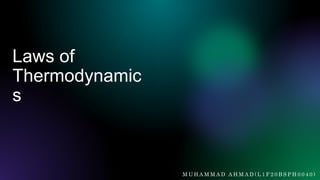
Laws of Thremodynamics
- 1. Laws of Thermodynamic s M U H A M M A D A H M A D ( L 1 F 2 0 B S P H 0 0 4 0 )
- 3. 1st Law • The First Law of Thermodynamics states that energy can be converted from one form to another with the interaction of heat, work and internal energy, but it cannot be created nor destroyed, under any circumstances. ΔU=q+w • ΔU is the total change in internal energy of a system, • q is the heat exchanged between a system and its surroundings, and • w is the work done by or on the system.
- 4. • Work is also equal to the negative external pressure on the system multiplied by the change in volume: w=−pΔV where P is the external pressure on the system, and ΔV is the change in volume. This is specifically called "pressure-volume" work. ΔUsystem=−ΔUsurroundings
- 5. 2nd Law • The Second Law of Thermodynamics states that "in all energy exchanges, if no energy enters or leaves the system, the potential energy of the state will always be less than that of the initial state." Eff=W=1−QcQhEff=WQh=1−QcQh •This is also commonly referred to as entropy.
- 7. 3rd Law • The Third Law states, “The entropy of a perfect crystal is zero when the temperature of the crystal is equal to absolute zero (0 K).” S – S0 = 𝑘B ln𝛀 • S is the entropy of the system. • S0 is the initial entropy. • 𝑘B denotes the Boltzmann constant. • 𝛀 refers to the total number of microstates that are consistent with the system’s macroscopic configuration.
- 8. CHEMICAL REACTIONS This Photo by Unknown author is licensed under CC BY. Abdulhannan Mirza(L1F20BSPH0016)
- 9. CHEMICAL REACTION The process through which substances convert into other substances is known as a chemical reaction. For example the formation of water from hydrogen and oxygen:
- 10. CATEGORIES OF CHEMICAL REACTION Chemical reactions are of the following categories: ○Exothermic and Endothermic ○Spontaneous and Non-Spontaneous ○Reversible and Non-Reversible On the basis heat evolution the two categories are, Exothermic Reactions: The chemical reactions which release energy during the process. Endothermic Reactions: The chemical reactions which absorb energy during the process.
- 11. SPONTANEOUS AND NON- SPONTANEOUS REACTIONS The propagation of a reaction determines whether it is spontaneous or not: Spontaneous Reactions: If a reaction is capable of initiating or propagating on its own it is called spontaneous. Non-Spontaneous Reactions: If a reaction is not capable of initiating or propagating on its own it is called spontaneous.
- 12. SPONTANEOUS REACTIONS These reactions have the following properties: • They are exothermic. • The reactants are at a higher energy level than products. • There Gibbs energy is negative.
- 13. NON-SPONTANEOUS REACTIONS: These reactions have the following properties: • They are endothermic. • The reactants are at a lower energy level than the products. • There Gibbs energy is positive.
- 14. GIBBS ENERGY AND SPONTANEITY: Gibbs Energy The energy required to initiate a reaction is known as its Gibbs energy. This energy determines the spontaneity of a reaction, since it tells whether a reaction will absorb or release energy on initiations.
- 15. Gibbs energy of Spontaneous Reactions: If the value of Gibbs energy for a reaction is negative, it means that it will release energy on initiation and hence it will be spontaneous. Gibbs energy of Non-Spontaneous Reactions: If the value of Gibbs energy for a reaction is positive, it means that it will absorb energy on initiation and hence it will be non-spontaneous.
- 16. Reversible and Non- Reversible Reactions Muhammad Uzair
- 17. REVERSIBLE & IRREVERSIBLE A chemical reaction is the one in which a substance converts into another, this is what is known as a non-reversible reaction. In some reactions the converted substance also coverts back into the original substance, these are known as reversible reaction.
- 18. PROPERTIES OF REVERSIBLE REACTION: • Two reactions forward and reverse take place simultaneously. • Forward reaction slows down over time while reverse reaction speeds up. • The end result of the reaction is Equilibrium state.
- 19. CHEMICAL EQUILIBRIUM: • The point in a reversible reaction where the forward and reverse reaction take place at the same rate. • The number of reactants converting into products is equal to the number of products converting into reactants. • The reaction does not stop but appears to be stationary. • Further product cannot be yielded without somehow disturbing the equilibrium.
- 20. THERMOCHEMISTRY OF REVERSIBLE REACTIONS: Thermochemistry deals with the heat energy absorbed or released in a reaction. It studies the effect of temperature on chemical reactions. The equilibrium state can be affected by temperature and its effect can be determined by thermochemistry.
- 21. EFFECT OF INCREASING TEMPRATURE: • Increasing the temperature causes heat to transfer from surrounding to the system, which favours exothermic processes while diminishes endothermic processes. • If the forward reaction is exothermic the increasing temperature increases the rate of it while the endothermic reverse reaction is slowed, thus more product is formed. • If the forward reaction is endothermic the increasing temperature decreases the rate of it while the endothermic reverse reaction speeds up, thus more reactant is formed.
- 22. EFFECT OF DECREASING TEMPRATURE: Decreasing the temperature causes heat to transfer from the system to the surrounding , which favours endothermic processes while diminishes exothermic processes. If the forward reaction is endothermic the decreasing temperature increases the rate of it while the exothermic reverse reaction is slowed, thus more product is formed. If the forward reaction is exothermic the decreasing temperature decreases the rate of it while the endothermic reverse reaction speeds up, thus more reactant is formed.